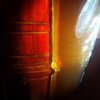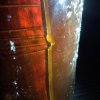-
The BladeForums.com 2024 Traditional Knife is ready to order! See this thread for details: https://www.bladeforums.com/threads/bladeforums-2024-traditional-knife.2003187/
Price is$300$250 ea (shipped within CONUS). If you live outside the US, I will contact you after your order for extra shipping charges.
Order here: https://www.bladeforums.com/help/2024-traditional/ - Order as many as you like, we have plenty.
You are using an out of date browser. It may not display this or other websites correctly.
You should upgrade or use an alternative browser.
You should upgrade or use an alternative browser.
To Chiruwa or not - That is the question
- Thread starter snowwolf
- Start date
- Joined
- Apr 29, 2015
- Messages
- 69
Day one (no noticeable improvement)
View attachment 540367
Well form I've read about the *Pugs* method, is it took 3 -4 days of soaking, & sometimes a second run of soaking after that.
That is a lot of shrinkage! I would round off the metal edge with a file now, when it is well exposed. Just to take off a minimal amount of metal so the tang doesn't have sharp edges.
If the wood actually comes all the way back you could make the edges match again with a little sanding.
If the wood actually comes all the way back you could make the edges match again with a little sanding.
- Joined
- Mar 28, 2013
- Messages
- 1,730
Now see, I'd soak before I filed. Get the wood back as much as possible (it's taken me a week on some non H-I knives before). Put it somewhere you can forget it for a bit, maybe fondle another knife or two and come back in a couple days.
- Joined
- Nov 11, 2013
- Messages
- 1,976
I like David`s suggestion (file now while it`s well exposed) to round off the edges a little.
Btw I didn't expect much after a day but I prefer taking the pic now as opposed as. Been sorry - I "should of" document this better after the fact.
I'll post here the picture of the day. Day after day... Creating some sort of thread and opening the bets for the amount of recovery we'll get.
(Probably just as exiting as watching hairs growing) :yawn: :yawn:
:yawn:
Btw I didn't expect much after a day but I prefer taking the pic now as opposed as. Been sorry - I "should of" document this better after the fact.
I'll post here the picture of the day. Day after day... Creating some sort of thread and opening the bets for the amount of recovery we'll get.
(Probably just as exiting as watching hairs growing) :yawn:
- Joined
- Aug 26, 2010
- Messages
- 7,755
...
(Probably just as exiting as watching hairs growing) :yawn::yawn:
Trust me it is!
http://www.bladeforums.com/forums/s...nk/page7?highlight=how+much+mineral+oil+asare
- Joined
- Jun 24, 2013
- Messages
- 4,162
Lol ndoghouse
It actually was super exciting.
I wonder how much influence the room/oil temperature has.
It actually was super exciting.
I wonder how much influence the room/oil temperature has.
- Joined
- Nov 11, 2013
- Messages
- 1,976
Lol ndoghouse
It actually was super exciting.
I wonder how much influence the room/oil temperature has.
That's another thing. I was tempted to increase the temperature with a light. Currently it's Canadian "normal" room temperature +- 65 deg
- Joined
- Aug 26, 2010
- Messages
- 7,755
I think the type of wood probably has the most effect on how much absorption you get. The piece in my test was Asare and is a very light porous wood. Satasal is very dense and dont seem to soak up near as much (maybe it does?) but we all know it shrinks cracks. That test KLVUK still has an oily sheen to it but it doesnt feel slippery or oily when using it. If I did it all over again I think id soak it one day in mineral oil wipe it clean and then about three days in BLO or something similar to what pugs is doing. I think as long as you put something on the handle and maintain it you wont have a problem with it. Getting it back to original shape may not ever happen since you cant rehydrate it with water without rusting things. One of these days id like to build a vacuum chamber from a piece of clear tubing large enough to slip a Khukri inside and make two end caps to close it off. I have a vacuum pump for air condition service I could easily pull a vacuum on it to absorb stabilizing chemicals into the wood while on the Khukri. I think Id start with Satisal and treat it as oak for starters. I dont know the effects of stabilizing chemicals on steel or laha for that matter so it may not be possible? It would be fun to experiment with tho.
- Joined
- Jun 24, 2013
- Messages
- 4,162
I heated mine 2 minutes in the microwave until it became borderline uncomfortably hot.That's another thing. I was tempted to increase the temperature with a light. Currently it's Canadian "normal" room temperature +- 65 deg
It stayed hot for a loooong time. Much much longer than water would.
Did it make a difference? I dont know since I didnt compare identical wood with and without heat. It became less viscous for sure and should soak in better but maybe warm woods fibers behave differently? So it seems likely to work better but not 100 percent sure. Yet.
A combination of of cold and heat might work the oil in even better if the fibers kind of open and close under temperature changes and work the stuff in. Pure speculation of course and kind of calling for an experiment.
Got some sparewood lying around....
- Joined
- Aug 28, 2010
- Messages
- 5,431
...One of these days id like to build a vacuum chamber from a piece of clear tubing large enough to slip a Khukri inside and make two end caps to close it off. I have a vacuum pump for air condition service I could easily pull a vacuum on it to absorb stabilizing chemicals into the wood while on the Khukri. I think Id start with Satisal and treat it as oak for starters. I dont know the effects of stabilizing chemicals on steel or laha for that matter so it may not be possible? It would be fun to experiment with tho.
I didn't grasp how a vacuum would increase the absorption, so I looked into the process for stabilizing wood. The vacuum removes air from the pores and voids in the submerged wood. It's after the vacuum is removed that the submerged wood more readily absorbs the liquid resin (at normal atmospheric pressure). The wood then needs to be baked to harden the resin (for the process I read about, at least).
Bawanna
Moderator
- Joined
- Dec 19, 2012
- Messages
- 10,346
It's quite a complicated process and for best durability and use the formula has to be correct.
I purchased some stabilized wood from a guy and made gun grips. Everyone cracked and broke after just a few shots.
Still would make nice knife handles where they are glued and pinned on but couldn't handle being held on with screws and recoil.
A new outfit I use explained to me the first guys formula was off and they were too brittle.
The new outfits slabs have never had an issue of any kind. You can get it clear or with different color dyes, beautiful stuff, just bloody expensive.
He said it could be done at home but it's trial and error and takes some effort to get it right.
I wish I could do it myself for a lot less but I suspect it won't happen.
I purchased some stabilized wood from a guy and made gun grips. Everyone cracked and broke after just a few shots.
Still would make nice knife handles where they are glued and pinned on but couldn't handle being held on with screws and recoil.
A new outfit I use explained to me the first guys formula was off and they were too brittle.
The new outfits slabs have never had an issue of any kind. You can get it clear or with different color dyes, beautiful stuff, just bloody expensive.
He said it could be done at home but it's trial and error and takes some effort to get it right.
I wish I could do it myself for a lot less but I suspect it won't happen.
- Joined
- Mar 28, 2013
- Messages
- 1,730
If there's no more improvement by say, the end of the week, I'd get the file ready.
I've been applying Ballistol two or three times a day to two horns for 5 days.
Not seeing much improvement there.
I do like the look of the horns, but I'm thinking I'll stick to wood from here on out.
The wood on the Chitlangi Bowie hasn't shrunk much at all since '06.
Denis
Not seeing much improvement there.
I do like the look of the horns, but I'm thinking I'll stick to wood from here on out.
The wood on the Chitlangi Bowie hasn't shrunk much at all since '06.
Denis


